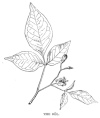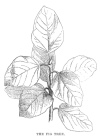
Sacred Texts Hinduism Index Previous Next


Hindu Mythology, Vedic and Puranic, by W.J. Wilkins, [1900], at sacred-texts.com
Several trees are regarded as sacred; they being representative of, or peculiarly dear to, some of the deities. It is a meritorious act to plant and water them, and such is the respect cherished for them, that even their withered branches are not allowed to be burnt. The

Click to enlarge
THE BANYAN TREE.
same ceremonies are observed at the planting of these trees, or, when they have been taken care of for some time, at their consecration, as are observed at the setting up of an image. The following are the names of the sacred trees:—
The Asvatta, or Pipul. Tree (Ficus religiosa), sacred to Vishnu.
The Vata, Banyan or Indian Fig Tree * (Ficus Indica), also sacred to Vishnu.
The Vilva, or Wood-apple, or Bēl Tree (Ægle Marmelos), sacred to Siva.
The Vakula (Mimusops Elengi).
The Harltāki (Terminalia chebula).

Click to enlarge
THE BĒL.
The Amalaki, or Emblic Myrobalans (Phyllanthus emblica).
The Nimba, or Nim Tree (Melia azadirachta).
The Tulsi (Ocimum gratissimum or sanctum).
The Tulsi is very commonly worshipped by the followers of Vishnu; and the plant is most carefully tended
as his representative. Every morning the ground near it is cleaned with cow-dung and water; at night a lamp is hung before it. During the two hottest months of the year, a vessel of water is hung over it so that it constantly receives moisture. When a plant dies, it is cast into a river, the same honour being given to it as to an image as soon as the worship of it is concluded. It is a common custom to place a sprig of Tulsi near the head of a dying person. The origin of the worship of this plant is said to be the following: A woman named Tulsi engaged in religious austerities for a long period, and asked, as a boon, that she might become the wife of Vishnu. Lakshmi, hearing of this, cursed her, and changed her into the plant which bears her name. Vishnu, however, comforted his follower with the assurance that he would assume the form of the Shālgrāma, and continue near her. * The Vāyu and the Padma Purānas teach that the Tulsi was one of the products of the churning of the ocean.
In addition to these trees should be mentioned the Durva grass (Agrostis linearis) and Kusa grass (Poa cynosuroïdes), which form part of the offerings made to the gods; as do the leaves or flowers of most of the trees previously mentioned. The Mahābhārata has a legend accounting for the sacredness of the Kusa grass. When Garuda brought some of the amrita from the moon for the Nāgas, or serpent deities, as the price to be paid for his mother's release from servitude, Indra tried to induce him not to give it to them lest they, becoming immortal, should oust him from his throne. Garuda would not consent to this arrangement, but told Indra that after it was given to them he could steal it.
Garuda therefore placed the amrita in a vessel on the grass, and whilst the Nāgas were bathing, Indra stole it. They, thinking that the ambrosia must be on the Kusa grass, licked it; the sharp spikes slit their tongues, and hence the serpents' tongues are forked; and the grass, having been touched by the amrita, is holy.

Click to enlarge
THE FIG TREE.
471:* Ward, ii. 204.